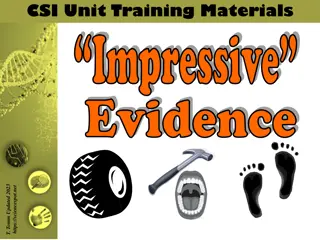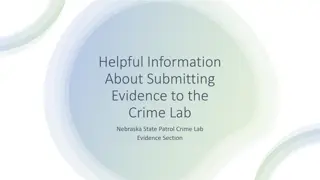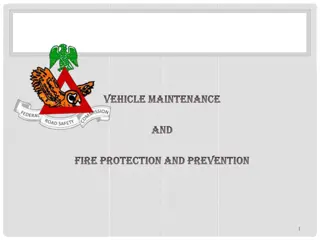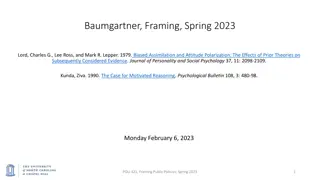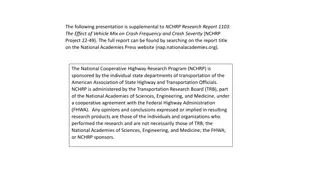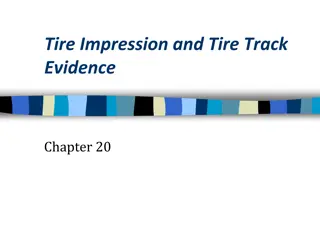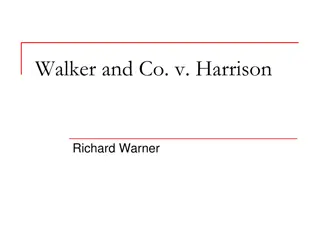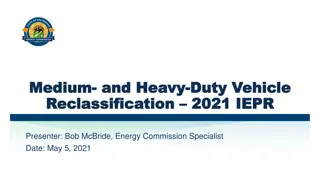Vehicle Track Evidence Analysis by Dr. Walker
Detailed documentation and analysis of vehicle track evidence conducted by Dr. Walker, focusing on measurements, tread patterns, tire size, and unique identifiers that can be crucial in associating a vehicle with a crime scene.
Download Presentation

Please find below an Image/Link to download the presentation.
The content on the website is provided AS IS for your information and personal use only. It may not be sold, licensed, or shared on other websites without obtaining consent from the author.If you encounter any issues during the download, it is possible that the publisher has removed the file from their server.
You are allowed to download the files provided on this website for personal or commercial use, subject to the condition that they are used lawfully. All files are the property of their respective owners.
The content on the website is provided AS IS for your information and personal use only. It may not be sold, licensed, or shared on other websites without obtaining consent from the author.
E N D
Presentation Transcript
Tracking Evidence Dr. Walker
Vehicle Track Evidence Objective: To determine a match of tire tracks and/or vehicle make and model from tracks made in soft earth
Write all Vehicle Track Evidence Basic Measurements Wheelbase Axle to axle distance
Write all Vehicle Track Evidence Basic Measurements Front Track Width Distance between center points of front tires Rear Track Width Distance between center points of rear tires
Write all Vehicle Track Evidence Basic Measurements Tread design width The measurement across the tread from one edge of the tread design to the other. Turning diameter Minimum distance that vehicle requires (curb to curb) to make a complete circle (360-degree turn).
Write all Vehicle Track Evidence Basic Measurements Tread design depth The tread pattern depth on a tire (on site or from an impression.) New tires (passenger vehicles) are 11/32 to 12/32 Most mud or snow tires are 14/32 to 16/32 Decreases over time due to wear
Write all Vehicle Track Evidence Basic Measurements Tire circumference The full circumference of a tire. Cuts, stains, or rocks may aid in obtaining this value Actual measurements may be different than real tire values Expansion/compression due to temperature changes within the tire.
Write all Vehicle Track Evidence Tire Size 235/60R16 235 Width of tire in millimeters 60 Aspect Ratio (height of sidewall/width of tire) 16 Diameter of tire in inches
Write all Vehicle Track Evidence Tread patterns are often unique, and patented, for each manufacturer Brand of tire can often be determined from the tread pattern. As the vehicle is driven, the tires develop wear patterns. Some wear faster on the front tires, some on the back. There may be random cuts, nicks, or stones in the tread. They all leave unique impressions at the crime scene that can be used to positively associate a vehicle with a crime.
Write bold Forensic Geology All forensic geology is designed to establish the degree of probability that a sample is derived from a given place However, there are no mechanized ways to produce probability estimates.
Write all Components Of Physical Evidence The Soil Itself The following may be included Rocks Minerals Fossils
Write all Forensic Geology Soil Any disintegrated surface material, both natural and artificial, that lies on or near the earth s surface. Soil may include: Rock, minerals, vegetation, animal matter, glass, manufactured objects, asphalt, brick fragments, and paint chips.
Write all Forensic Geology Soil Analysis Side-by-side visual comparison of color and texture when dry. There are nearly 1100 distinguishable soil colors.
Write all Forensic Geology Types of Soil Residual Soil Soil formed in place by the weathering of rocks Transported Soil Soil that has been moved by nature By rivers or streams, to another location as mud, sand, or dust
Write all Soil Profile Most biological (or organic) processes take place at layers near the surface (depth < 15 ) Soil Profile Layering pattern of soil
Write all Rocks Three Types Igneous melting of older rocks Metamorphic formed by pressure Sedimentary Formed by weathering
Rocks Classified by size, shape, and the way the minerals fit together in the rock. Coarseness of the grain can be also classified, but the most defining feature is the prevalence of an index mineral comprising the vast majority of the rock Petrology is the name for the science of the study of rocks.
Write bold Minerals Minerals come in over 4000 varieties Only 200 are discussed in textbooks Only 20 are considered common Most samples may only have 4 or 5
Write all Minerals Every mineral has an unique atomic structure with fixed physical and chemical properties Classified as light or heavy based on specific gravity Classified by color, luster, fracture, cleavage, streak
Write all Mineral Terms Luster Describes the way light is reflected from its surface Streak Color of the powder left behind when the mineral is rubbed against a hard, rough surface Fracture Rough, uneven breakage Cleavage Breaks along a smooth, definite line
Write bold Mineral Terms Hardness Ability of a mineral to resist being scratched An object with a higher number will scratch an object with a lower number Moh s Hardness Scale
Write bold Mineral Terms Light vs. Heavy Refers to specific gravity Specific gravity related to density Indicates how many times more the mineral weighs compared to an equal amount of water Description very light SG Mineral Examples < 2 borax 2 - 2.5 2 3 3 - 4 4 5 5 10 light gypsum, halite, selenite, ulexite average calcite, dolomite, feldspar, muscovite mica, quartz, talc, turquoise, above average / slightly heavy biotite mica heavy almandine garnet, apatite, barite, celestite, chalcopyrite, fluorite very heavy galena, hematite, magnetite, nickel-iron, pyrite extremely heavy even for a metallic mineral super heavy > 10 gold, silver 20+must be platinum!
Write all Fossils Used by forensic geologists primarily to determine the age of rocks Carbon dating used for age determination


